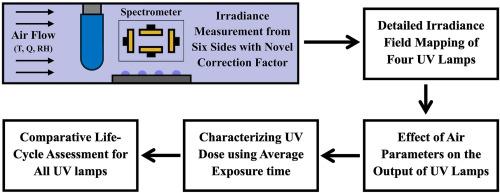Improved method for UV lamps irradiance characterization and life-cycle assessment for in-duct microbial inactivation
IF 7.4
2区 工程技术
Q1 CONSTRUCTION & BUILDING TECHNOLOGY
引用次数: 0
Abstract
Accurate characterization of ultraviolet (UV) irradiance is essential for the effective design and evaluation of in-duct air disinfection systems. This study aims to develop a novel angular correction factor to address sensor detection-angle limitations. Experimental irradiance measurements were conducted for 222 nm excimer lamp, 254 nm mercury lamp, 265 nm UVC LED and 365 nm UVA LEDs, and their environmental sensitivity was assessed under varying air temperature, velocity, and relative humidity. The comparative life-cycle assessment evaluated energy, costs, and environmental impacts for achieving a 3-log microbial reduction. Findings show that the correction factor reduced overestimation by up to 30 % near lamp surfaces, with a maximum error (18 %) observed farther from the 254 nm lamp. Model-based scalability from single LED modules to full arrays yielded an average relative error of ±13 %, supporting flexible LED arrangements. The 254 nm lamp output increased by 18 % as air temperature rose (25–35 °C) and decreased nearly to 80 % as velocity increased (0.5–2 m/s). In contrast, the 222 nm lamp and both LED systems showed minimal sensitivity, indicating greater operational stability under dynamic conditions. While LEDs and 222 nm offer their own advantages, they require higher energy and cost to achieve equivalent disinfection. Therefore, under continuous in-duct application, the 254 nm lamp is the most sustainable and cost-effective option among those tested. This study provides a validated, building-scale framework that improves measurement accuracy and supports energy-aware implementation, offering actionable guidance for optimized, sustainable deployment of UVGI in building ventilation systems.

改进的紫外灯辐照度表征和管道内微生物灭活的生命周期评估方法
准确表征紫外线(UV)辐照度对于有效设计和评估管内空气消毒系统至关重要。本研究旨在开发一种新的角度校正因子,以解决传感器检测角度的限制。实验测量了222 nm准分子灯、254 nm汞灯、265 nm UVC LED和365 nm UVA LED的辐照度,并评估了它们在不同空气温度、速度和相对湿度下的环境敏感性。相对生命周期评估评估了实现3对数微生物减少的能源、成本和环境影响。研究结果表明,校正因子减少了高达30%的高估近灯表面,最大误差(18%)观察到远离254纳米灯。从单个LED模块到全阵列的基于模型的可扩展性产生了±13%的平均相对误差,支持灵活的LED布置。当空气温度升高(25-35°C)时,254 nm灯的输出增加18%,当速度增加(0.5-2 m/s)时,输出减少近80%。相比之下,222 nm灯和两种LED系统都显示出最小的灵敏度,表明在动态条件下具有更高的运行稳定性。虽然led和222纳米具有自身的优势,但它们需要更高的能量和成本来实现等效的消毒。因此,在持续的管道应用中,254 nm灯是所有测试中最具可持续性和成本效益的选择。该研究提供了一个经过验证的建筑尺度框架,提高了测量精度,支持节能实施,为优化、可持续地部署UVGI在建筑通风系统中提供了可操作的指导。
本文章由计算机程序翻译,如有差异,请以英文原文为准。
求助全文
约1分钟内获得全文
求助全文
来源期刊

Journal of building engineering
Engineering-Civil and Structural Engineering
CiteScore
10.00
自引率
12.50%
发文量
1901
审稿时长
35 days
期刊介绍:
The Journal of Building Engineering is an interdisciplinary journal that covers all aspects of science and technology concerned with the whole life cycle of the built environment; from the design phase through to construction, operation, performance, maintenance and its deterioration.
 求助内容:
求助内容: 应助结果提醒方式:
应助结果提醒方式:


